How to Design Pallet Racks to Meet the Needs of Your Space
15th Jun 2020

Whether you're reconfiguring your existing pallet rack layout or investing in a new rack system altogether, details matter.
Taking the time to correctly measure, configure and lay out your setup is the key to avoiding costly re-dos down the road. It can also make your warehouse safer.
Are you running out of floor space? Not sure where to begin? That's why we're here.
Today, we're sharing a guide to configuring and measuring your pallet racks to make sure they meet the needs of your space. An optimized racking system can transform your warehouse, improve productivity and enhance operations, so it's important to get it right.
Ready to learn more? Let's get started.
CONSIDER ACCESSIBILITY REQUIREMENTS
Right now, you might be looking for any solution that will get your inventory off the floor, clear a path for your employees and make your warehouse a more productive facility. However, not just any pallet rack solution will do the job. You need one customized for your organization, and to know what kind that is, you'll need to understand why you're looking for a new or improved racking system in the first place.
A FEW KEY QUESTIONS TO ANSWER OR DISCUSS WITH YOUR TEAM INCLUDE:
- Do we keep a lot of the same products in stock or different types of products?
- Do we need to store a lot of products in a small area?
- How frequently do we need to access those products?
- How many pallets do we need to store?
- How much do our typical pallet loads weigh?
With those answers in mind, you can decide which kind of racking system is the best fit. There are several different kinds to choose from, including:
SELECTIVE PALLET RACKING
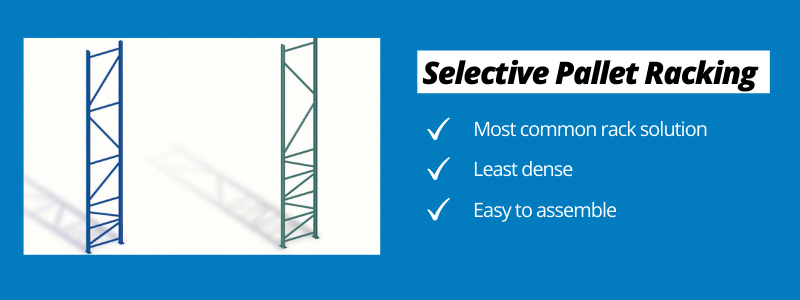
This is the most common rack solution, providing direct access to all kinds of products. While it might be the least dense option on the list, the ease of access makes it popular with warehouse managers around the world.
PUSH BACK PALLET RACKING
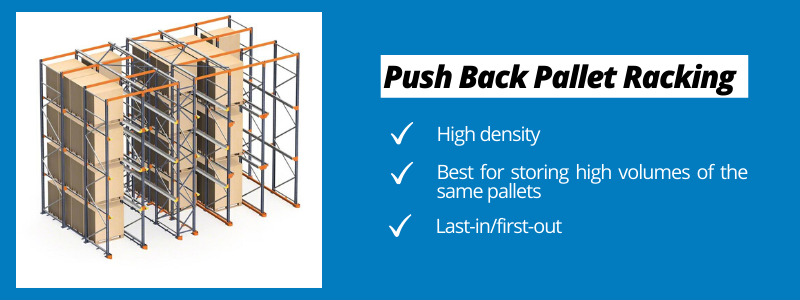
This is a high-density solution best-suited for storing a high volume of pallets that contain the same product. Configured as a last-in/first-out system, it can store between two to five pallets deep.
PALLET FLOW RACKING
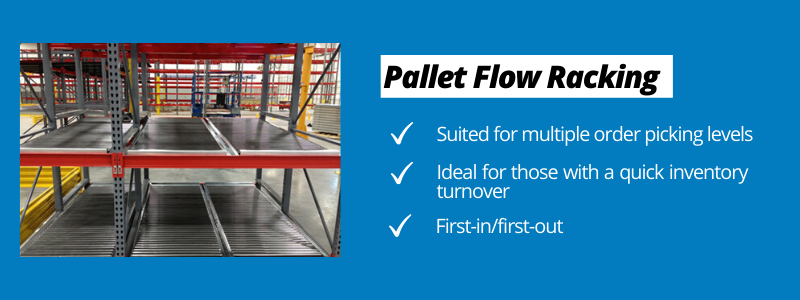
If you require multiple order picking levels, this high-density solution can facilitate. Perfect for businesses that see quick inventory turnover, it's based on a first-in/first-out system.
CANTILEVER RACK
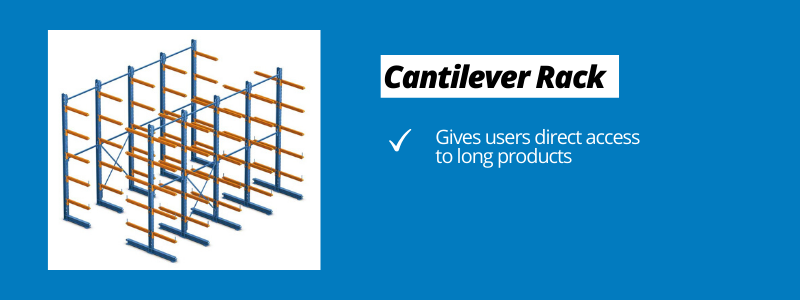
This kind of racking system helps workers have direct access to long products, including timber, fabric molts, metal and more.
DRIVE-IN / DRIVE-THRU PALLET RACKING
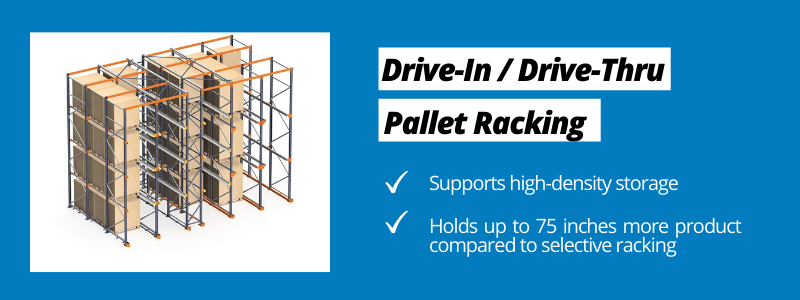
Like push back pallet racking, this design also supports high-density storage when you have a lot of the same inventory types. Compared to selective racking, it can hold up to 75 inches more product while using 35 inches less floor space.
CARTON FLOW PALLET RACKING
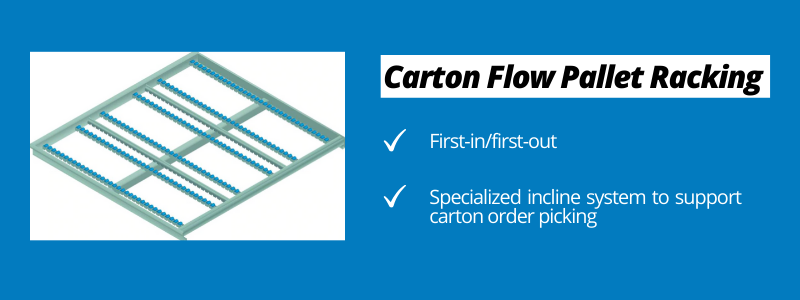
Another first-in/first-out setup, this is a specialized incline system that supports carton order picking.
UNDERSTAND YOUR RACKING RUN
When you're trying to determine your storage requirements, one of the best places to start is to determine the ideal length of your racking run. For most organizations, this will be equal to the length of your warehouse, or at least the part of your facility with floor space that you intend to use for racking.
Eventually, you'll need to calculate the exact number of runs you'll actually need. At this juncture, however, you can calculate the racking required for one run and go from there.
DETERMINE YOUR PALLET REQUIREMENTS
Your next step will be to measure the length and height of your beams. Before you even begin the measuring process, however, consider how many pallets you plan to rest on the rack. What will you be storing and how much space will it take up in your system?
Taking your inventory requirements into account, do you need the rack to be one-pallet wide? What about two or three pallets wide? There is no right or wrong answer, but you want to make sure you're allotting enough space for the storage you require.
SIZING YOUR PALLETS
From there, the next question is: What size pallet do you plan to store on the rack? While standard, Grocery Manufacturer Association (GMA) pallets measure 48 inches deep by 40 inches wide, there are other sizes available. You can even have custom pallets made to fit your exact requirements.
To determine the height of your pallet, you don't need to measure the actual pallet by itself. Rather, consider the height of the load that will be placed on top of it as well. When you add those numbers together, you get a clearer and more accurate view of how high your pallet rack system needs to be. You'll also be able to better discern the number of beams that you can fit into that height.
In addition to your pallet size, consider also the type of pallets you intend to store, as well as their unique construction.
Do you plan to use pallets that don't have any bottom deck board affixed to the blocks? If so, keep in mind that racking design best practices require pallets to sit directly on the beam itself. Thus, without deck boards, you'll need to invest in a special accessory, such as wire decking, to make sure your pallets don't fall through.
You'll also need to know the weight of the standard pallets you plan to store. This is important because the pallet weight will influence the frame specification, as well as rack configuration, beam capacity, and warehouse floor load weight.
Communicate with your executive team, warehouse manager and other key personnel to get these requirements nailed down. This might take a little extra time, but details including dimensions, capacities and layout directly effect the cost, as well as safety. You definitely want to design your setup around the right pallet rack specifications.
MEASURE YOUR BEAMS
With your run length in place, you can start thinking about beam length.
Selective pallet racking systems come equipped with both horizontal cross beams and an upright frame. There are a few different standard lengths for the beams, including:
- 8 feet
- 9 feet
- 10 feet
- 12 feet
Note that while these are the most common beam length options, they aren't the only ones. Different vendors will have their own variations, so you aren't required to make these sizes work in your space.
Are you replacing existing racks or installing new ones? If it's the former, you'll need to take extra caution at this step.
Most people tend to measure from the outside of the uprights. Doing so can render an inaccurate measurement. Instead, make sure to measure each one from the inside edge.
If you're installing new beams, use the information gathered during your pallet rack discussion to determine the beam lengths you'll need. Say, for example, you decide to use the standard GMA 40-inches wide by 48-inches deep pallets, storing two pallets per rack. In this case, you'll need to account for a total of 80 inches in width.
However, you can't stop at the bare minimum. Building and fire codes will require that you add an extra five inches of clearance on either side of the uprights. You'll also need at least six inches of space between the pallets. Thus, your beam length moves from 80 inches to 80 + 10 + 6, which equals 96 inches.
What happens if you decide to store three pallets per rack, instead of two as in the example above?
In that scenario, you'll need to multiply 40 by three, equalling 120 inches. Then, remember to add in the clearance on both sides of the uprights, as well as the required spacing between the pallets. That takes your total beam length to 120 + 10 + 12, or 142 inches. The closest standard size would then be the 12-foot beam.
Before you move onto the next step, take a measurement of the beam face. This measures the actual beam from the top to the bottom. You'll need to know both the beam length, as well as the face, to make sure your beams can hold the weight that you need them to support.
MEASURE YOUR RACK DEPTH
Your next step is to measure the depth of your racks. You can calculate rack depth by measuring the width of the uprights that your beams will be attached to.
In most cases, you'll need to allow three inches to hang over both the front of the rack, as well as the back, for a total of six inches extra. Most selective rack configurations follow this practice. That means you can go ahead and subtract six inches from your actual pallet depth to make sure the rack you buy is deep enough.
This means for a standard 48-inch deep pallet, your racking depth needs to only be 42 inches. This will leave you with three inches of overhang that improves pallet accessibility, making them easier for forklifts to access.
While 42 inches is the most common depth for uprights, you're not limited to those. You can also find rack depths in the following dimensions:
- 24 inches
- 36 inches
- 44 inches
- 48 inches
Again, you can find different dimensions depending on the manufacturer you select. Remember how you measured beam length on the inside edge, rather than the outside? You'll reverse that practice, here. When measuring uprights, you'll go from one outside edge to the other outside edge.
MEASURE YOUR RACK HEIGHT
Now, you're ready to measure how high you want your rack to reach. Of course, one of the most pertinent calculations is your ceiling height. To maximize the utility of your pallet rack, you want to make excellent use of the height in your room. However, you'll have one important limitation to work around and consider: your forklift capabilities.
While you could design a towering rack that reached all the way to the top of your warehouse ceiling, do your forklifts have enough reach to meet that demand? In addition to equipment limitations, you'll also need to consider the dimensions of the tallest pallet load you plan to store in the rack.
Begin by calculating how much height your current pallet load will require between the beam elevations. Measure this using your tallest pallet load so you can always make sure you have plenty of space. With that figure in mind, you need to account for overhead clearance. This clearance needs to be at least four inches to allow forklifts to maneuver comfortably around the rack.
In addition to the pallet load, make sure to also include the dimensions of the pallet height when determining your ideal rack height.
If you're unsure how many levels your rack system will be able to handle, take your tallest point (your warehouse ceiling or your forklift's highest reach) and divide it by your level spacing to get a clear picture on the number of levels that can fit.
As you measure, keep in mind that you'll need to leave 18 inches of clearance below the sprinklers in your ceiling to stay compliant with building code regulations.
COMPILING AND CONFIGURING YOUR CALCULATIONS
To make sure your racking run will fit in your footprint, determine the total run length of your racking. To do this, calculate both your beam length AND your upright width (in most cases, it’s 3” wide).For a straight run of racking, you will always have one additional upright compared to your total number of bays in the run. For example, if you have 3 bays in your run, it will require 4 uprights total (1 starter bay which requires 2 uprights + 2 add-on bays which only require 1 upright = 4 total uprights).

If your footprint allows for 25’ of racking and you want Qty 3 – 8’ long bays in your run, your calculation becomes:
- 3 (number of bays) x 8’ (beam length) = 24’ (total beam length)
- 4 (number of uprights) x 3” (upright width) = 12” = 1’ (total upright width)
- 24’ (total beam length) + 1’ (total upright width) =25’ (total racking run length)
Now you can be confident that your racking run will fit into your footprint.
MAKE YOUR PALLET RACKS WORK FOR YOU
When you want to maximize your space using pallet racks, it all begins with asking simple questions around your space requirements and storage needs.
From there, you can dive into the advanced calculations required to nail down your specific For example, say your run length was 150 feet and your beams were 12 feet long. That makes your calculation 150/12, which is 12.5 and rounds down to 12. A 12-bay setup requires the width of 13 uprights at three inches each. This adds another 39 inches to your total calculation.
Now, your equation becomes:
- 12 x 12 (beam length)=144
- 144 x 8 (number of bays) = 1152
- 1152 x 13 = 14,976 inches, or 1,248 feet.measurements. From beam height to rack depth, it's important to take everything into consideration and not cut any corners.
LOOKING FOR INDUSTRIAL SHELVING DESIGNED TO HANDLE YOUR MOST
HEAVY-DUTY TASKS?
That's where we come in.
We offer a variety of warehouse racking solutions from a variety of top manufacturers, including Speedrack and Steel King. We'll work with you to help determine the right system for your space. Contact our team of experts today to discuss your storage needs and take the next step toward optimization.

 US Dollar
US Dollar